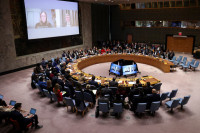Columns
BRI progress in Nepal
Nepal can leverage China's infrastructure and economic growth expertise through this initiative.
Kalyan Raj Sharma
As Prime Minister KP Sharma Oli prepares for his forthcoming China visit, the political debate in Kathmandu has reached a fever pitch. Within the Nepali Congress (NC), concerns about whether Nepal should embrace loans or grants through China’s Belt and Road Initiative (BRI) are rising. Recently, an esteemed Indian political analyst remarked in a private discussion that BRI could deeply reshape Global South’s development aspirations. For many low- and middle-income countries constrained by limited financial resources, the initiative offers a potential pathway to realise ambitious development goals, paralleling China’s rapid growth trajectory of recent decades. Despite contributing over 30 percent of the global economic growth, China’s development model, which challenges Western norms, has yet to be entirely accepted by many developed nations.
BRI’s core tenets highlight inclusive development and economic partnership, inviting participation from countries across different stages of development and socioeconomic contexts. Its six economic corridors aim to foster sustainable growth across Asia, Africa and Europe through policy coordination, infrastructure connectivity, unimpeded trade, financial integration and people-to-people connections. Guided by these principles, the initiative seeks to address pressing global challenges, including poverty, infrastructure deficits, climate change impacts, unemployment and food insecurity.
The initiative extends the principles of China’s open economy, offering an advanced framework for global economic integration that emphasises mutual benefits. As the global public good, BRI prioritises the free movement of goods, services, capital, technology and people to optimise resource allocation and maximise productivity through diverse, efficient partnerships. Chinese President Xi Jinping has framed the initiative as a 21st-century vision for an open socialist economy, emphasising equitable growth, cooperation and shared progress for modern human civilisation. As President Xi articulates, BRI is a modern extension of the Silk Road spirit—a “road of peace, prosperity, openness, innovation, and shared human advancement.”
For instance, Uzbekistan, a landlocked country, made the high-speed train in three years with BRI; the hydroelectric plant in Ecuador has boosted its economy; and the Jakarta-Bandung high-speed train in Indonesia ensured connectivity. Moreover, China-Laos rail and other cooperation projects being implemented in several parts of the world have resulted in substantial economic benefits to the receiving countries. The initiative has contributed to infrastructure cooperation and has had more to do with business. For instance, ASEAN countries, China’s largest trading partners, now have a trade of $975 billion, while it was only $40 billion in 2000. This was supported mainly by better connectivity after the BRI integration between China and ASEA -N member states.
China’s development approach, rooted in poverty alleviation and economic resilience, offers potential lessons. Since launching its reform and opening-up policies in 1979, the country has crafted an economic model grounded in structural adjustment, strategic integration with international markets and active participation in global economic governance. Over the past three decades, this approach has achieved transformative results, lifting over 800 million people out of poverty.
BRI presents a strategic opportunity for Nepal to advance development projects as there is a lack of vital infrastructure. Nepali leaders, policymakers and scholars should engage with the framework to prioritise projects that reduce trade deficits, enhance connectivity and unlock new avenues for economic growth. Under the initiative, Nepal could propose crucial infrastructure initiatives, such as developing transport corridors, AI-driven smart cities and agricultural trade routes. Strengthening trade connectivity with Tibet and neighbouring Chinese provinces could open markets for Nepali products, including cattle feed and high-value crops. Additionally, Nepal should advocate for enhancing additional border trade routes—such as Kimanthanka, Tipla-Pass, Hilsa and Dhau—to facilitate greater economic integration with China.
Rather than centring discussions on loans versus grants, Nepal’s leaders should engage in substantive negotiations with China to secure strategic commitments that align with Nepal’s long-term priorities. President Xi expressed his support for Nepal’s economic development during his visit in 2019, recognising the country’s latent potential despite its slower progress relative to nations with similar socioeconomic profiles. Nepal can capitalise on China’s expertise in rapid economic growth and infrastructure expansion by approaching the BRI as a nuanced, multidimensional initiative.
BRI embodies various economic principles and aspirations, including fostering equitable international relations, creating novel partnerships and ensuring mutual benefit. The key tenets of BRI, such as diplomacy, resilience-building and bridging development divides, open opportunities for Nepal to participate meaningfully in the initiative. Related initiatives, such as the Asian Infrastructure Investment Bank, Silk Road Fund and global value chain integration, offer additional partnership opportunities and resources.
Nepal should comprehensively analyse the BRI framework, identifying projects that address its economic and developmental needs. Oli’s upcoming visit to China is a critical opportunity to leverage BRI's transformative potential to advance Nepal’s prosperity. Positioning strategically within this global initiative, Nepal can commence sustainable growth and enhance connectivity with the broader international community.




 5.47°C Kathmandu
5.47°C Kathmandu















